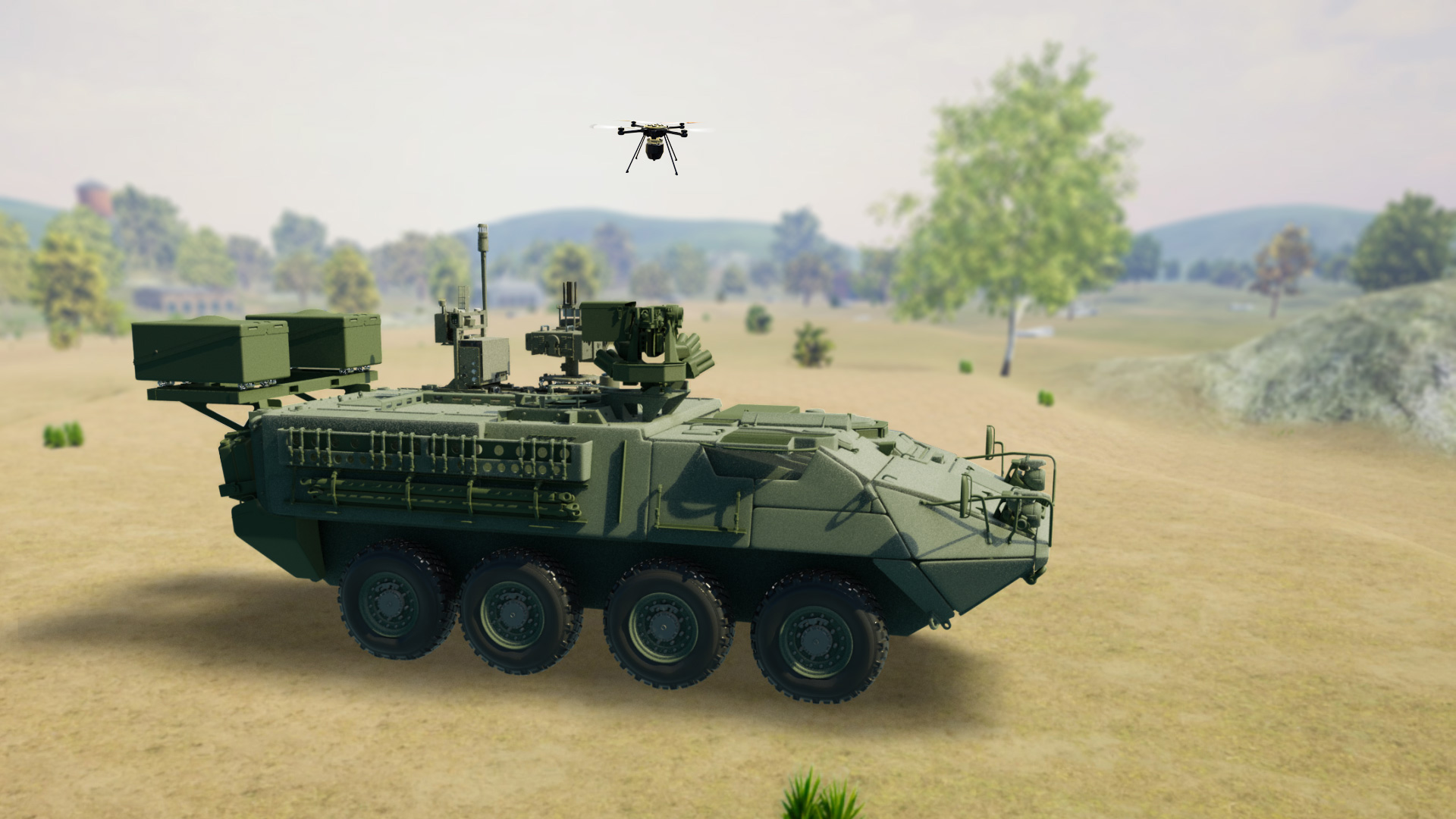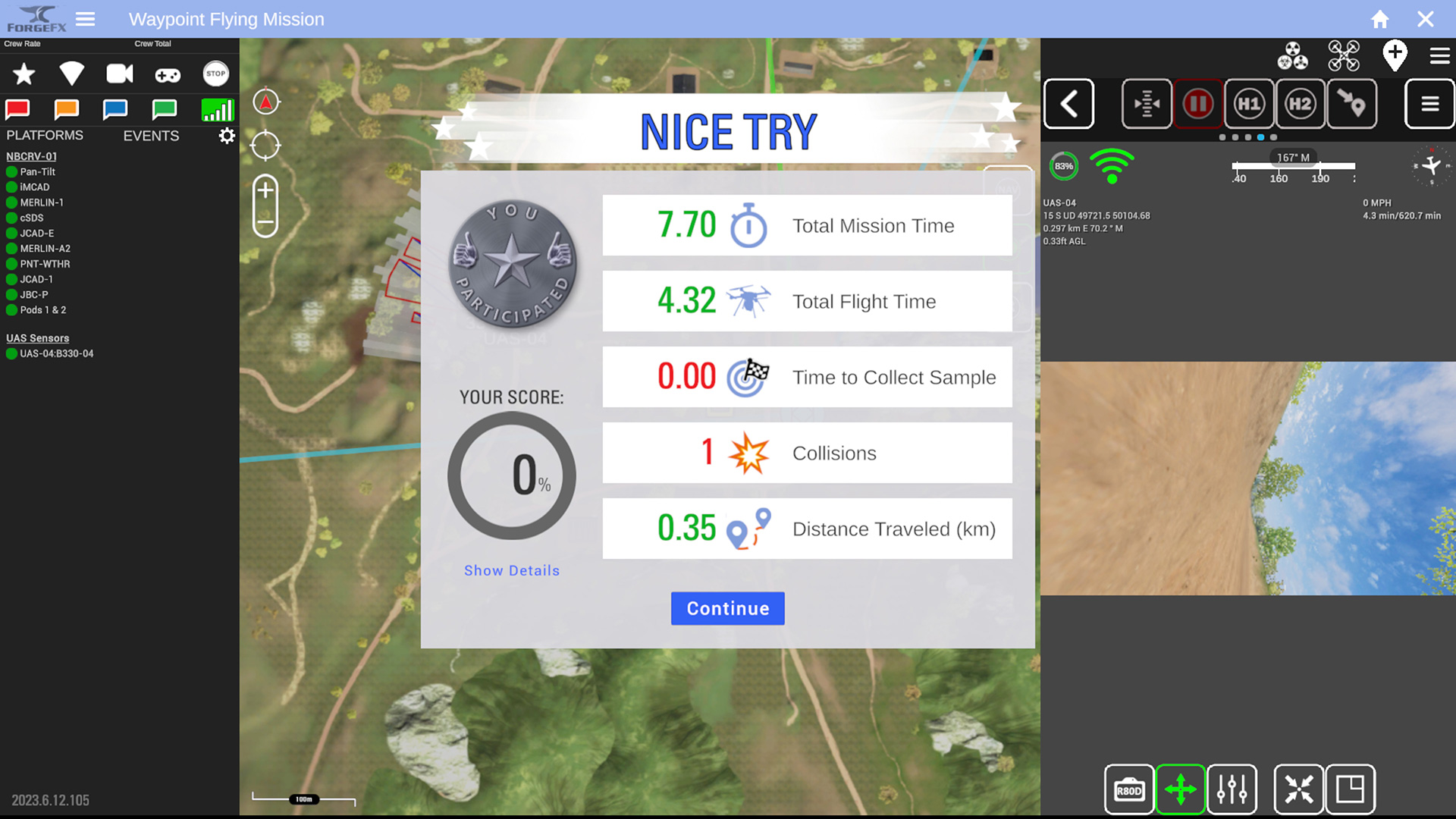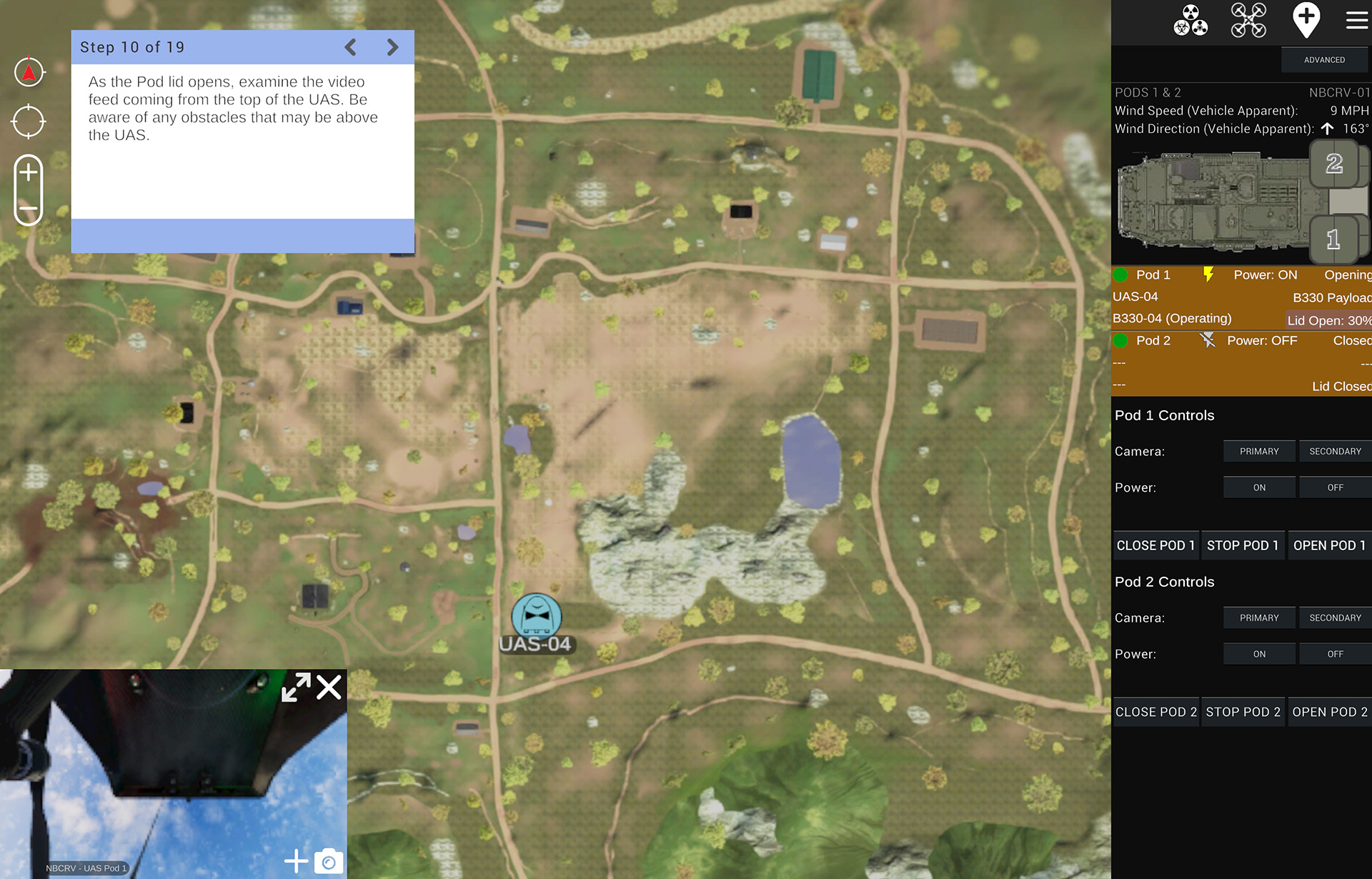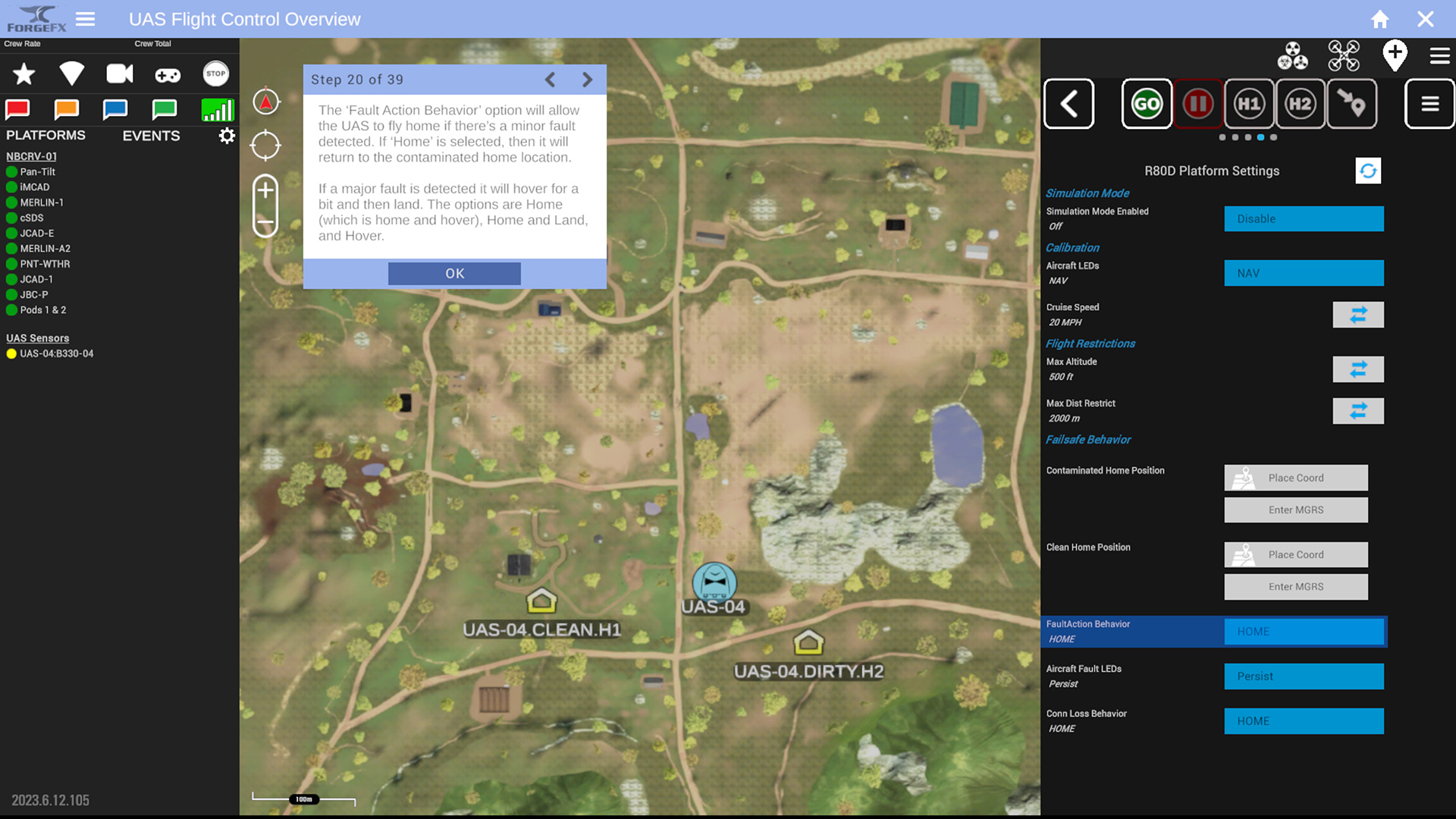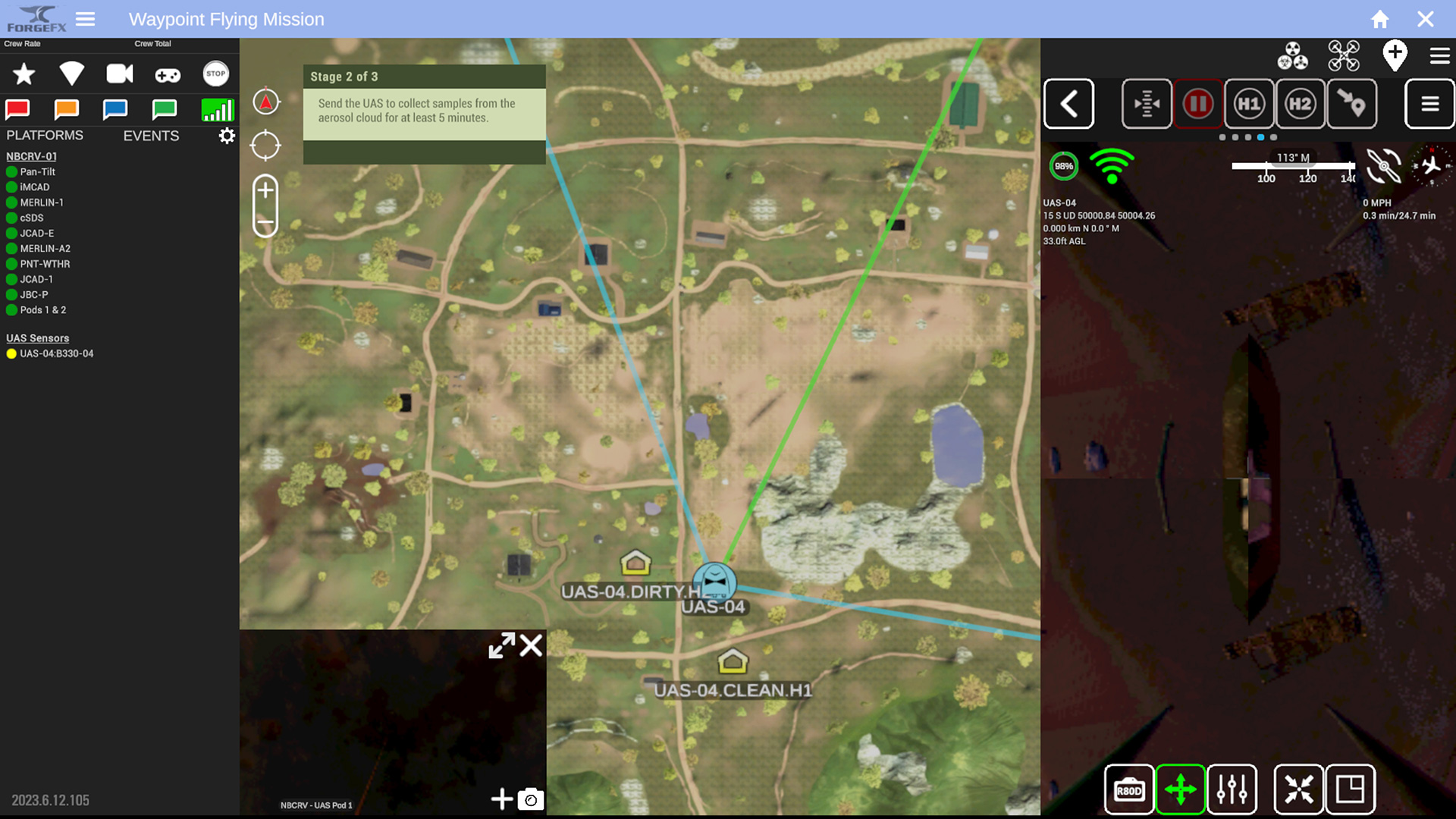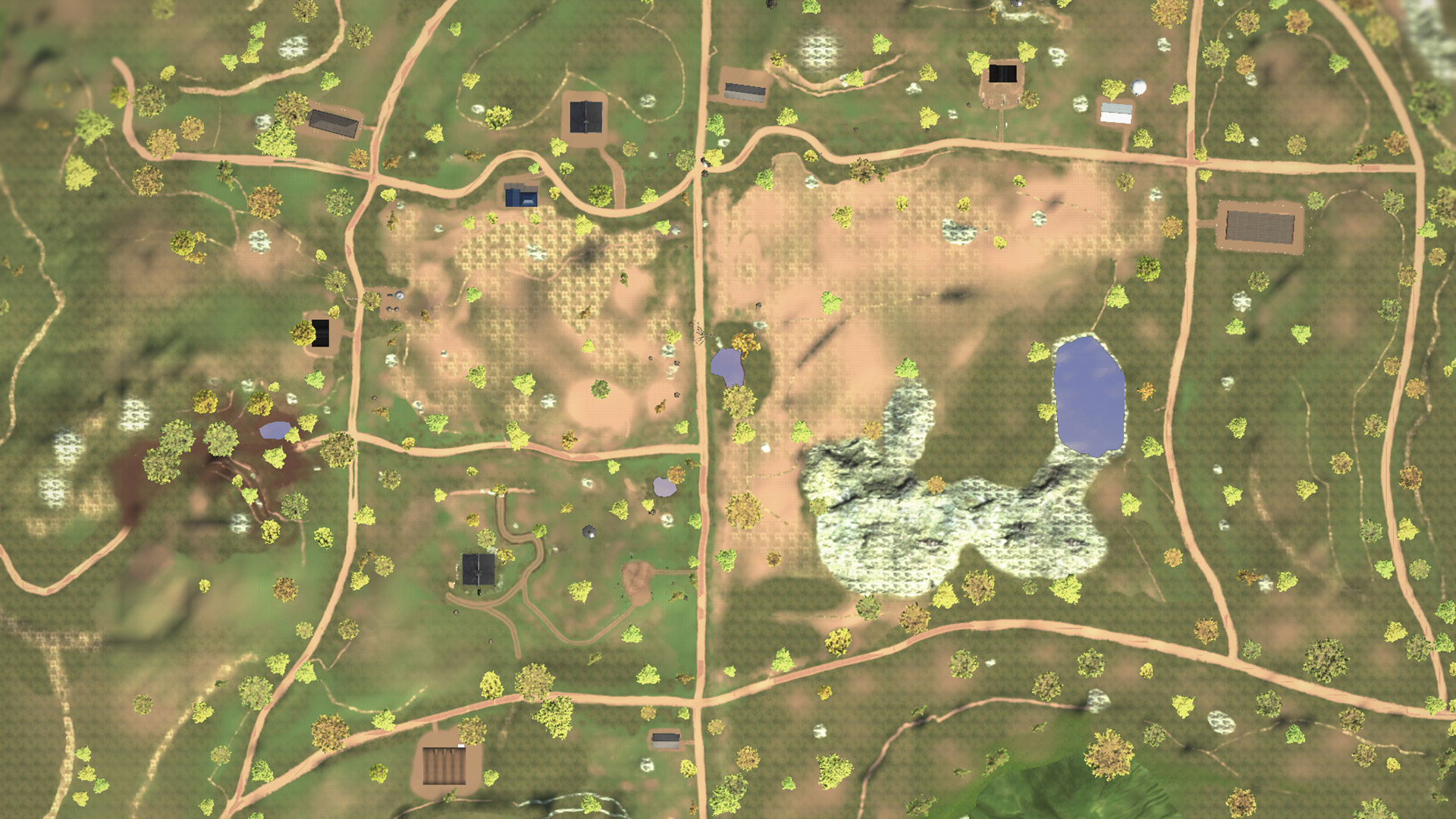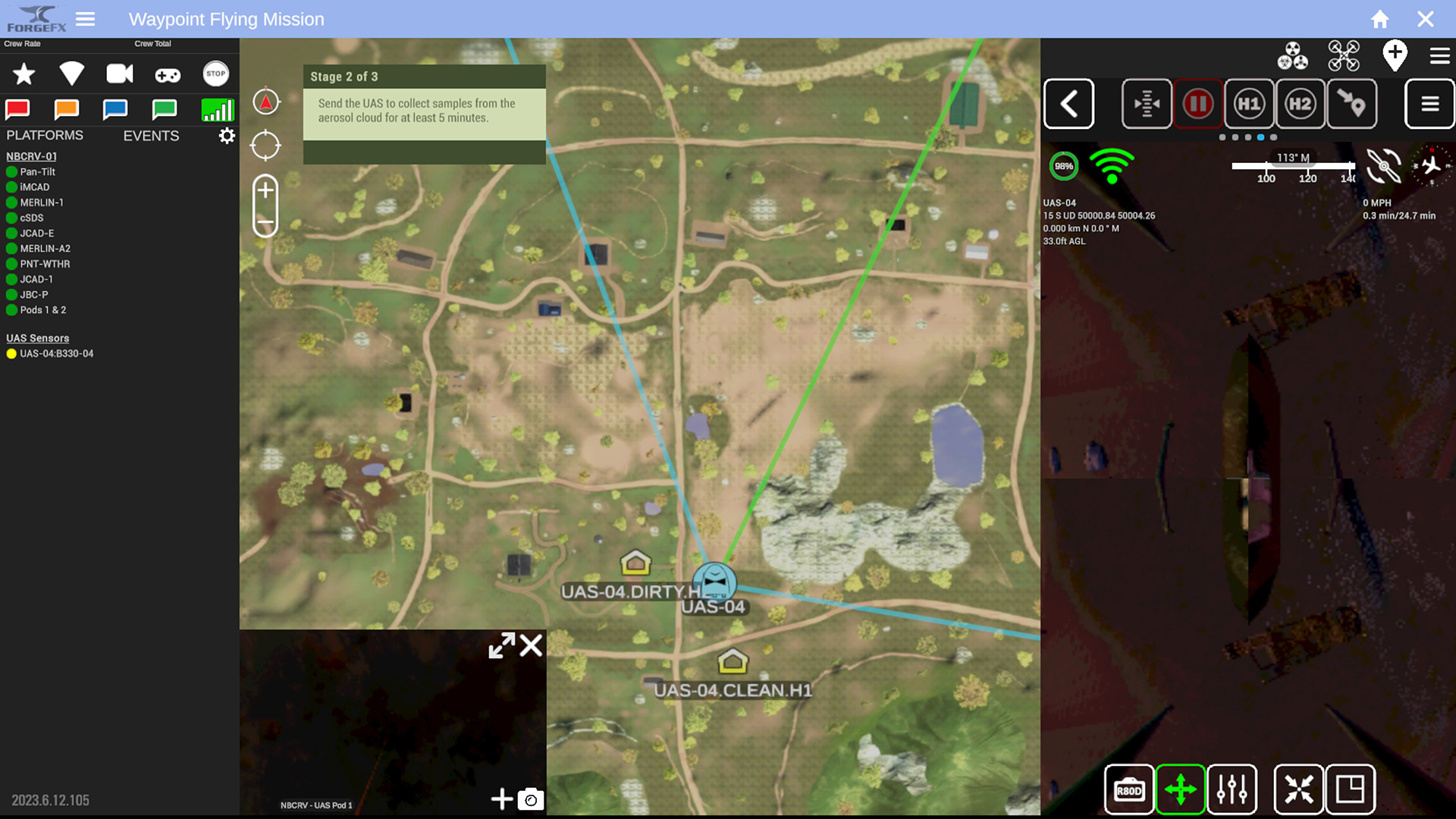JPEO-CBRND



ForgeFX Simulations is proud to present the simulation use cases of the Unmanned Vehicle Tele-Operation Training Simulator, a state-of-the-art training application developed in partnership with MRIGlobal for the Joint Program Executive Office – Chemical, Biological, Radiological, and Nuclear Defense (JPEO-CBRND), a division of the US Department of Defense responsible for protecting the nation from CBRN threats. This interactive 3D virtual training simulator is designed to instruct CBRND personnel in the remote operation of an Unmanned Aircraft System (UAS) from within a Nuclear Biological Chemical Reconnaissance Vehicle (NBCRV).
Working with Subject Matter Experts
Working directly with subject matter experts (SMEs) from the Department of Defense and Teledyne FLIR, ForgeFX Simulations created digital replicas of the physical and virtual product involved in this UAS, reproducing all the functions the physical objects perform in the real-world, and the virtual functions the software performs in the digital world. This simulator, running on a standard tablet computer, gives the JPEO-CBRND the ability to widely deploy simulation-based training to operators, who can master the complex controls and processes involved in operating a UAV and all of the onboard sensors it carries.
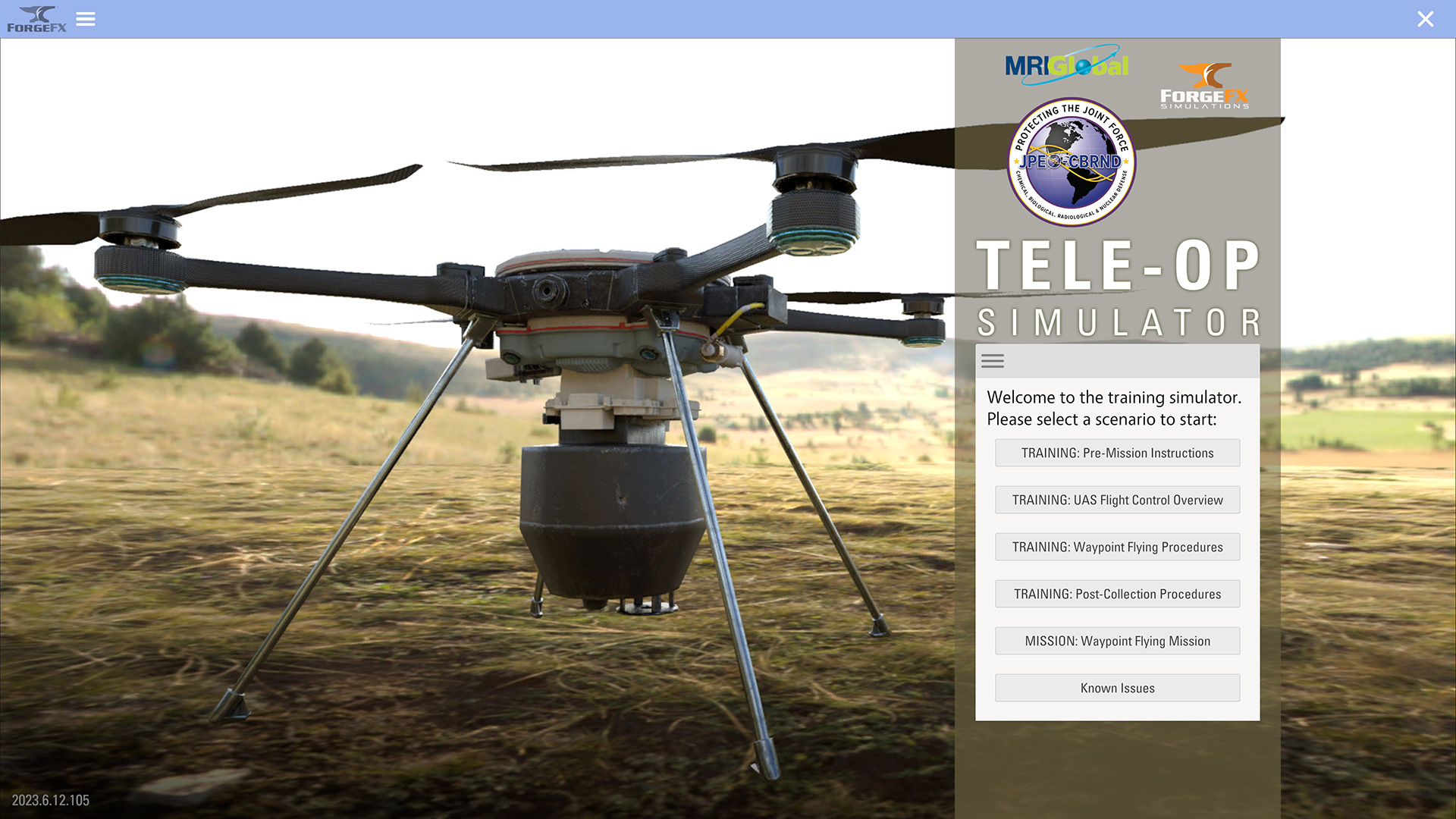
Tele-Op Simulator title screen featuring the R80D Skyraider by Teledyne FLIR.
Emulating Real-World Missions
The simulator recreates a CBRND reconnaissance mission featuring an NBCRV equipped with a sensor suite array and two pods, each containing a UAS. The UAS in the simulator is an R80D Skyraider drone carrying a MUVETM B330 Continuous Biological Detector and Collector payload, both manufactured by Teledyne FLIR. The Skyraider is launched from the NBCRV and directed into an area suspected to be contaminated by airborne substances. Operated by means of the ATAK application running on a tablet computer inside the NBCRV, the drone’s sensor payload helps the CBRND personnel triangulate on the position, speed, and contents of airborne contamination.
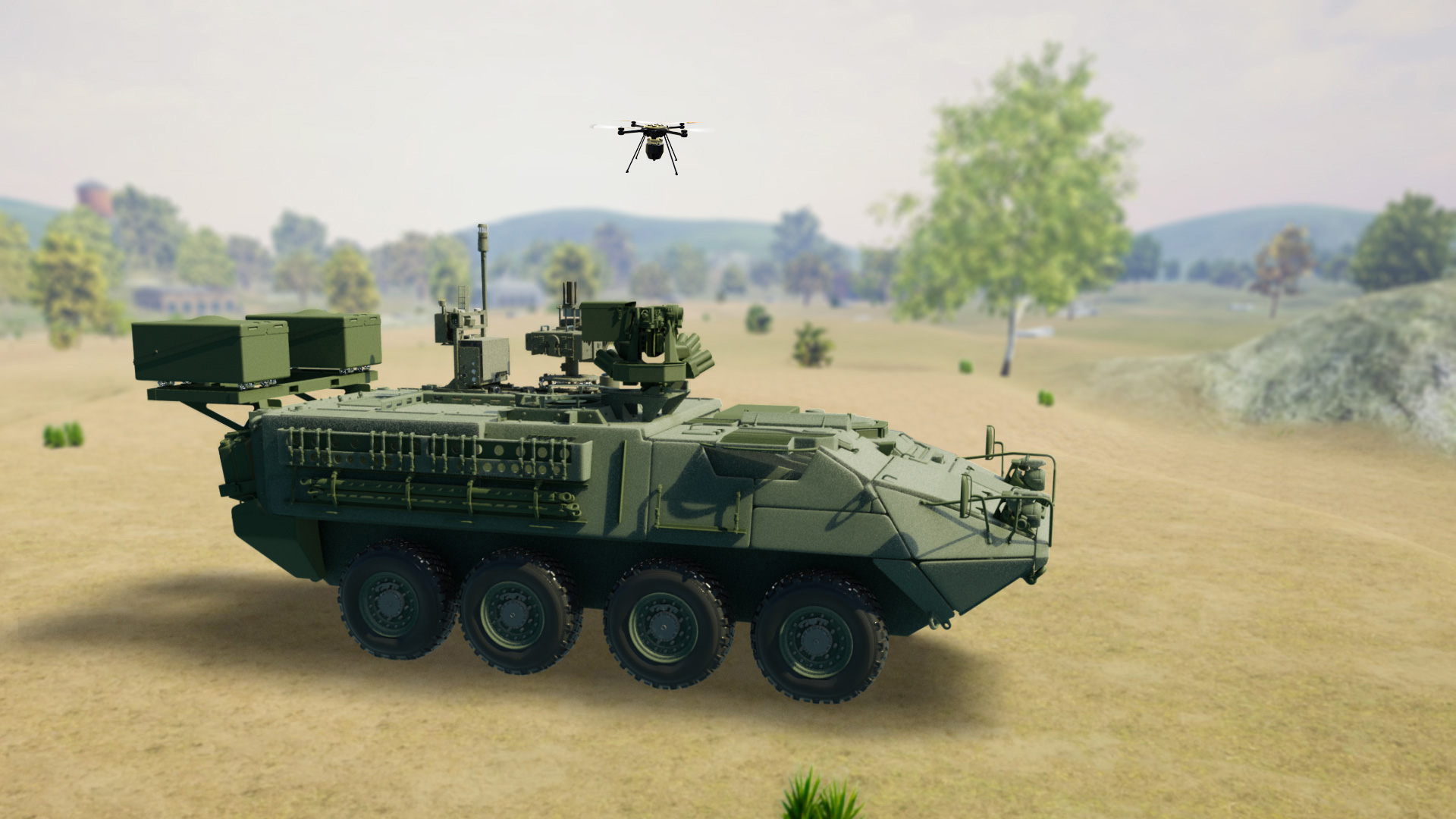
Nuclear, Biological, Chemical Reconnaissance Vehicle (NBCRV) and Unmanned Aircraft System Operator Training Simulator, by ForgeFX Simulations
Building on Past Projects and Experience
ForgeFX was able to expedite the delivery of the finished simulator due to the fact that they had previously developed the 3D terrain and much of the user interface elements for previous simulators for the JPEO-CBRND. For the Tele-Op Simulator, ForgeFX added dusk and night lighting conditions for the environment, created real-time interactive 3D models of the UAS and NBCRV systems, simulated the video feeds of multiple cameras, and developed the code that emulates the B330 sensor readings. Additionally, ForgeFX implemented AI-generated voiceover narration of the tutorial steps and simulated verbal radio communications.
Collaboration with Teledyne FLIR for Development
Teledyne FLIR provided support and guidance in ForgeFX’s endeavor to create a top-notch simulator. Teledyne FLIR’s SMEs furnished ForgeFX with critical CAD files of both the UAS and NBCRV, along with manuals, step-by-step procedural instructions, and invaluable unclassified videos from Skyraider testing sessions. Additionally, Teledyne FLIR invited ForgeFX to the U.S. Army Dugway Proving Grounds near Salt Lake City, Utah. Witnessing firsthand a testing session where the Skyraider and NBCRV detected a contaminated aerosol cloud offered clarity on the nuances that the Tele-Op Simulator had to incorporate. Throughout the development journey, Teledyne FLIR remained steadfastly involved, convening with the ForgeFX team bi-weekly through online sessions. Their unwavering commitment and interactive approach ensured the project’s direction was always aligned with realism and precision, fostering a relationship built on trust, transparency, and shared vision.
Procedural Training
The unmanned vehicle tele-operation training simulator includes four guided lessons and an unguided reconnaissance mission in which the techniques learned in the lessons are put to the test and the trainee’s performance is evaluated. Each lesson is methodical and interactive, simultaneously introducing the trainee to the placement and purpose of the controls while prompting them to perform the actions of the tasks. In this fashion the trainee is learning “on the job” with a skilled instructor.
Pre-Mission Instructions
The first lesson introduces two main aspects of the user interface: the controls for operating the two UAS pods to prepare for launch, and the components for deploying and controlling the B330 sensor payload. Instructions include directing the user how to interpret atmospheric conditions which can potentially halt the mission, and how to read the B330 sensor status and collection results. After activating the B330, the user is guided to activate the pod camera and open the pod. The pod camera video feed is shown in an inset window, and the user is instructed to look for obstacles that might impede the launch. Finally, the user learns about advanced features of the B330 collector, including the direction to only turn on the collector when the UAS is at height, and what kind of readings to look for when collecting samples from an aerosol cloud.

Pre-Mission Instructions focus on UAS pod controls in the right panel and show the pod camera view while the lid opens.
UAS Flight Control Overview
In this detailed lesson, the trainee is introduced to the interface section dedicated to programming the operating parameters and actions of the Skyraider and its several cameras prior to launch. The right part of the screen is occupied by the Operator View for the UAS, featuring a collage of the four feeds from the downward facing cameras.
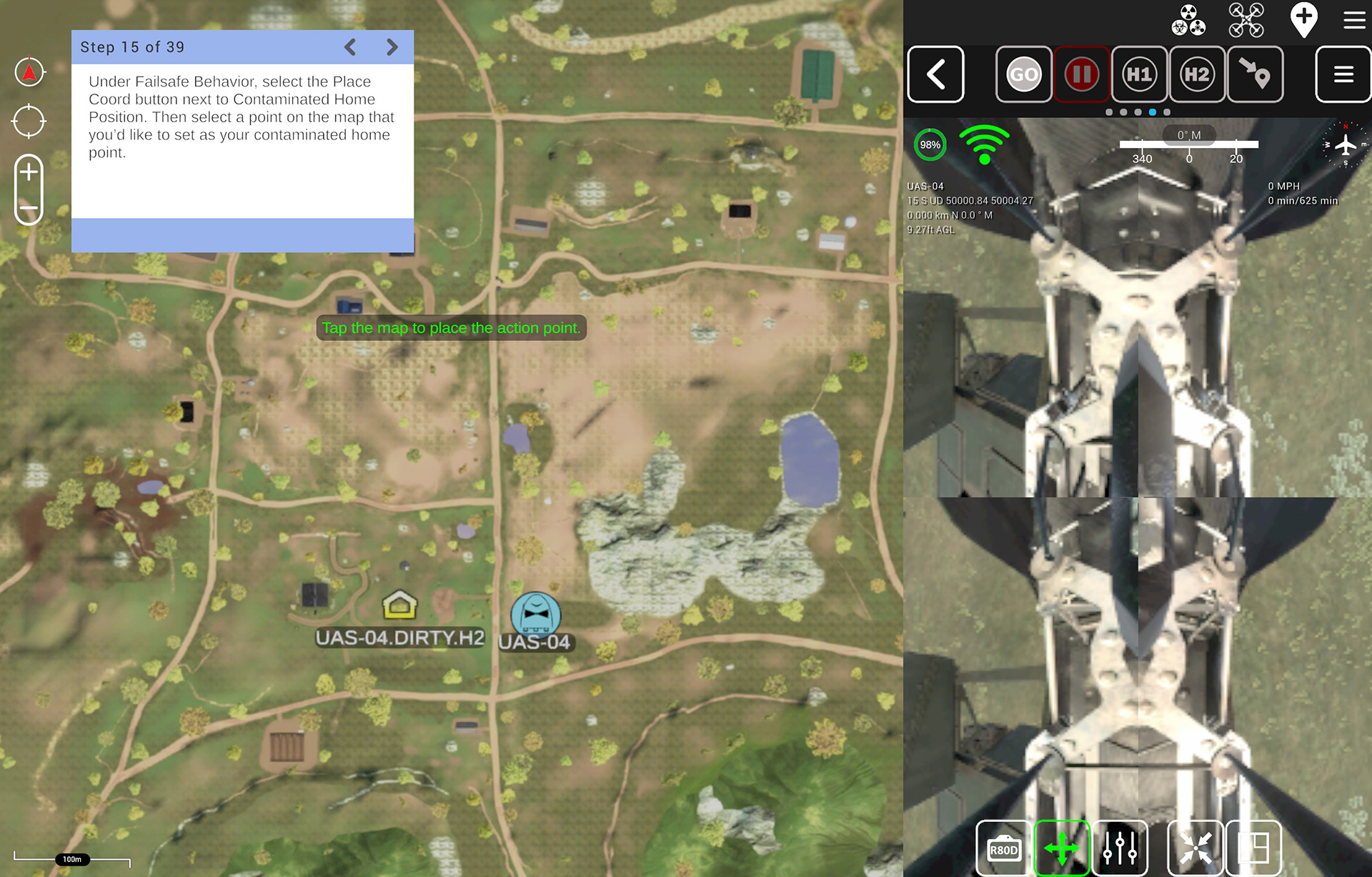
UAS Operator View while setting the home base locations prior to launch.
The lesson describes the purpose of these interface elements while stepping the trainee through the tasks of preparing the Skyraider for launch. One key task is to set “clean” and “dirty” home bases for the UAS to automatically return to once it has taken readings or if it encounters operational errors. Once the drone has been prepped for flight, the user pushes the Go button and hears the hum of the drone as it launches from its platform in the pod.
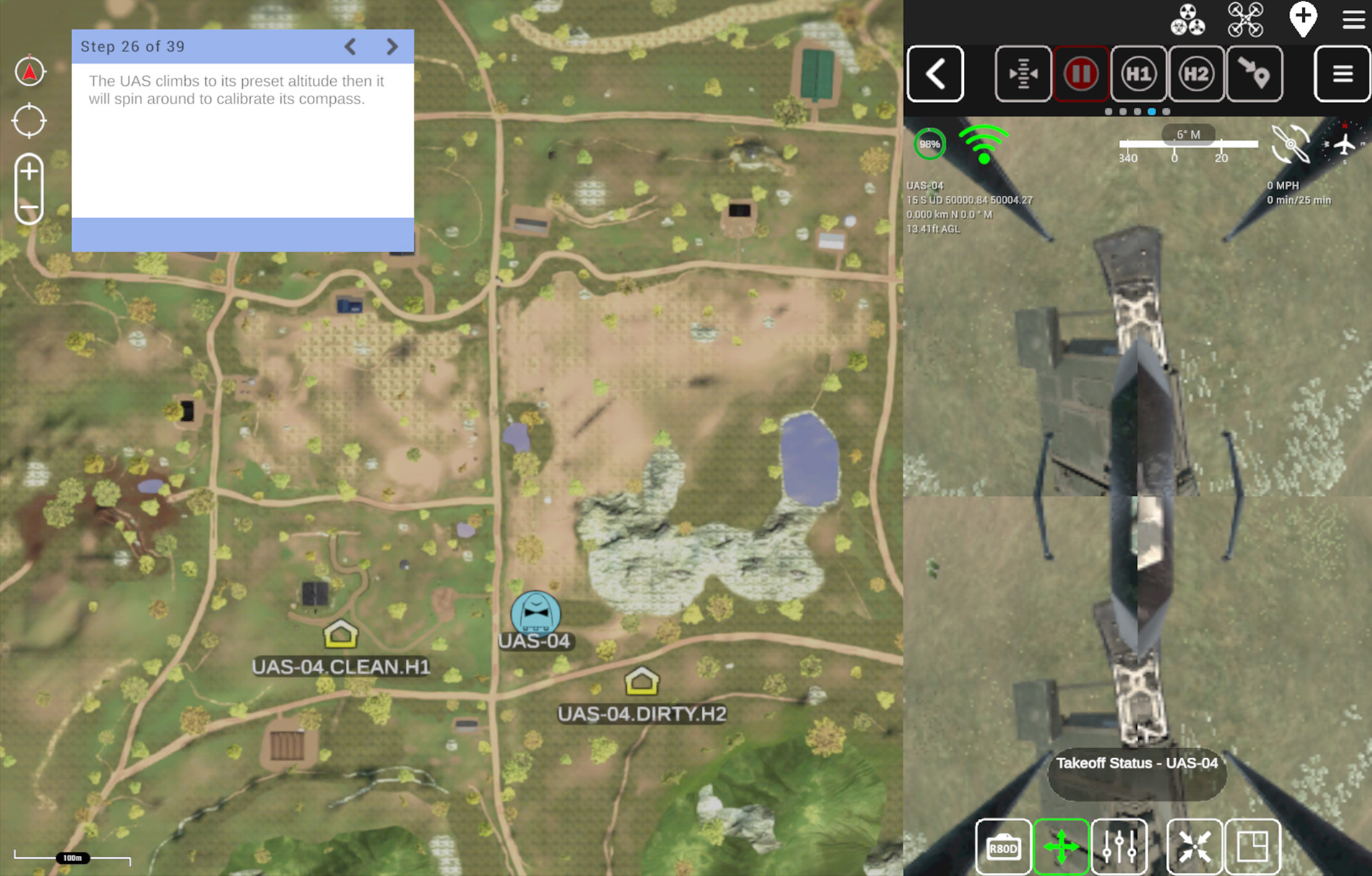
In mid-launch, view of the navigation cameras looking downward at the open pod on the NBCRV.
After being guided through the protocols of closing the pod lid, the user learns how to set a destination with the waypoint icon and a specified altitude for the drone to fly. The trainee can then practice setting destinations and flying to them. If the trainee directs the UAS to fly too low and a collision occurs, the camera feed simulates the tilting angle of the tumbling drone and then resets the drone to an acceptable hovering location. The final steps of this lesson guide the user in directing the UAS to land at a home base.
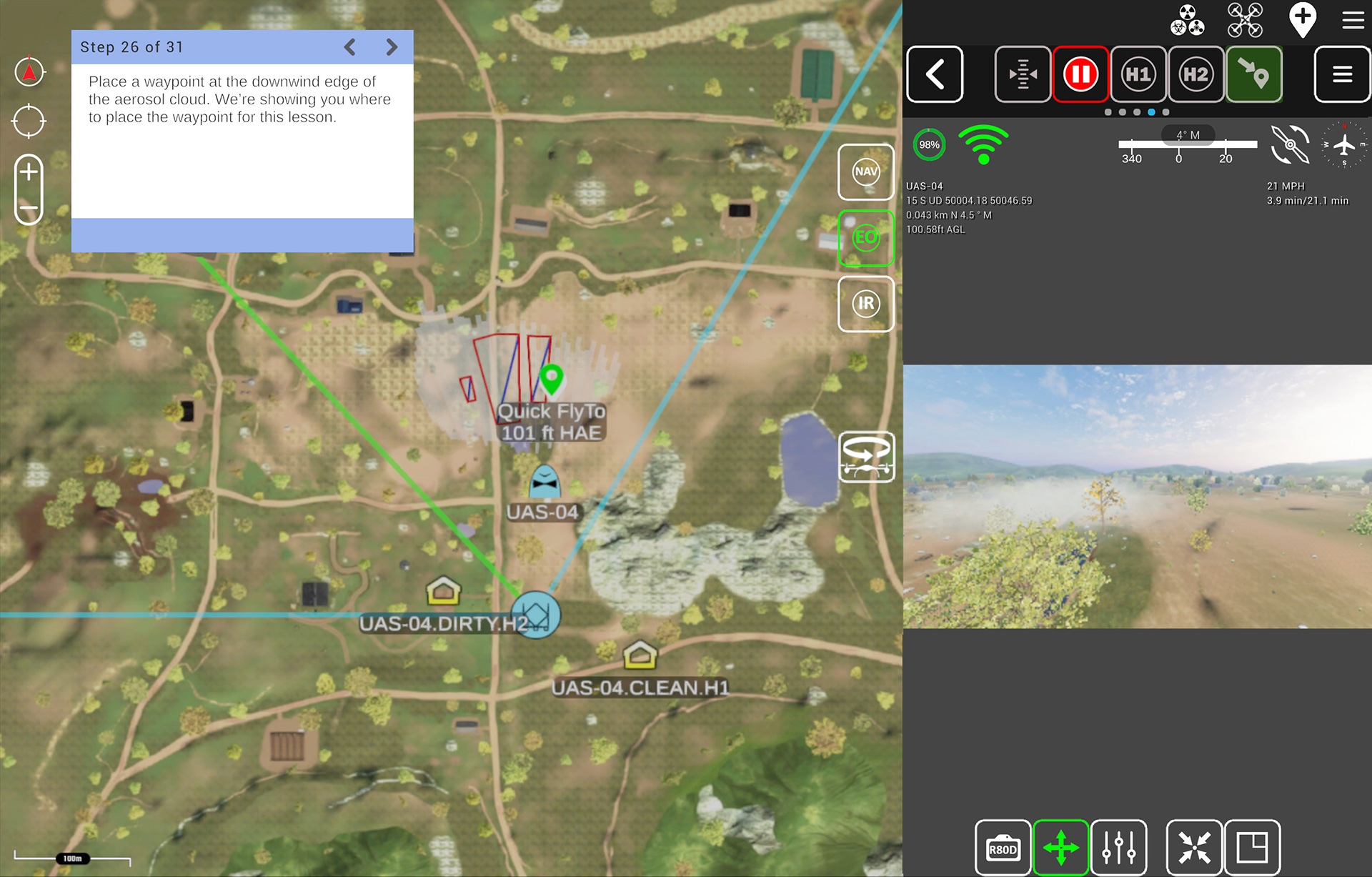
The UAS flies to the aerosol cloud, visible in the forward camera.
Designed to meet the rigorous specifications of the U.S. Government, the R80D is a robust multi-mission, semi-autonomous vehicle that can carry up to 7.7lb payloads and cruise at a ground speed of 31 mph. Nevertheless, letting one crash in the real world can delay or scrub a mission, not to mention lose thousands of dollars’ worth of equipment. Letting trainees practice operating a virtual Skyraider before testing their skills on the real version adds to the cost-effectiveness of the unmanned vehicle tele-operation training simulator.
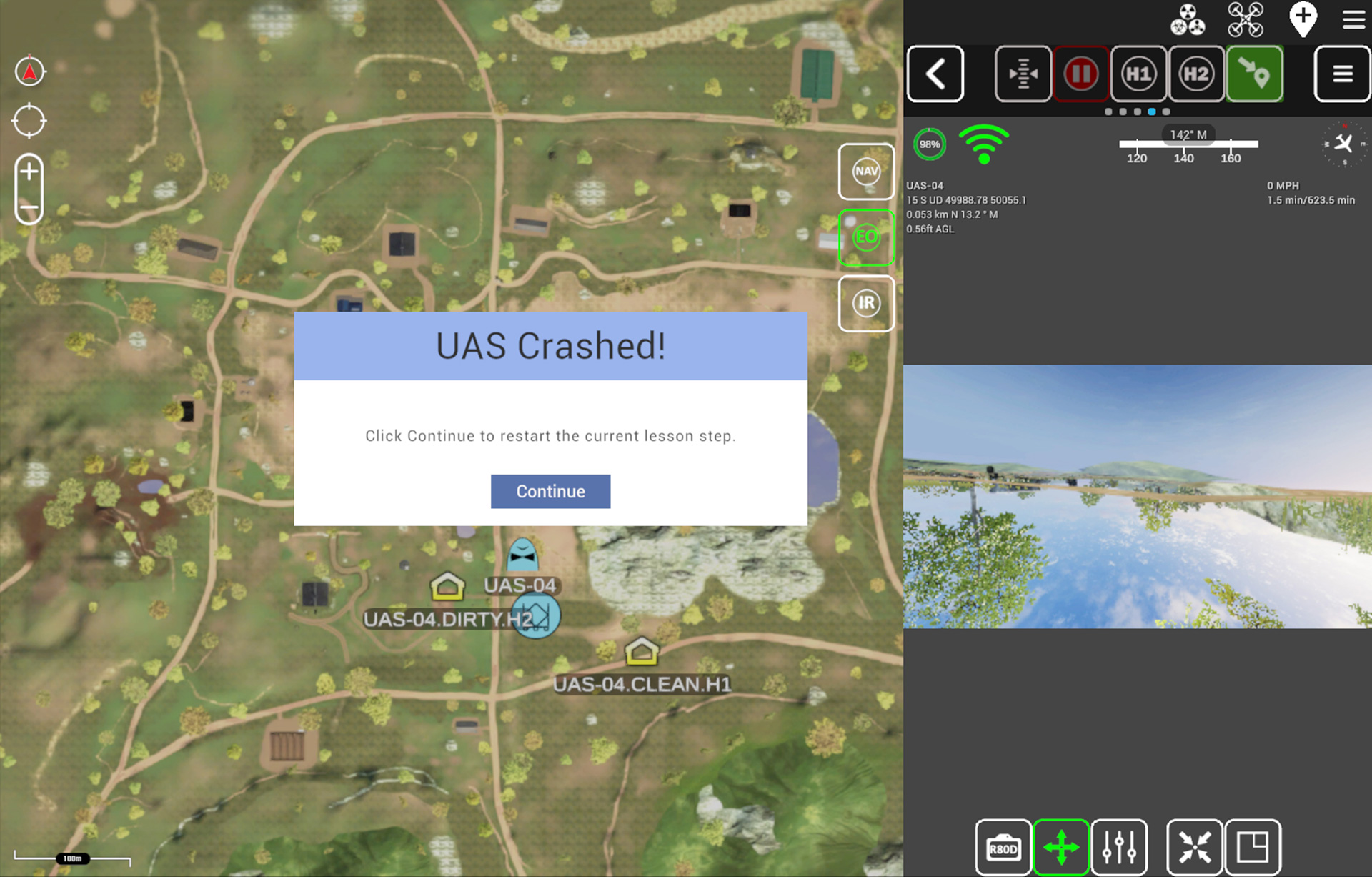
The camera feed spins as the drone tumbles out of a tree.
Waypoint Flying Procedures
This lesson reiterates the pre-flight and launching steps and then focuses in detail on the investigation of a contaminated area. The area appears on the map as a white area and in the forward-facing camera as a low white cloud. After launching the UAS, the user is directed to deploy the B330 sensor and to reset the baseline, which collects a clean reading for the sensor to compare against once it’s in the contaminated cloud.
The drone is sent to the contaminated area, where the user is instructed to switch to the downward cameras and use the B330 altitude preset to lower the drone into the aerosol cloud. The lesson directs the user to look at the Large Bio number for a particle amount in the thousands to indicate that the drone is in an adequate sampling area.
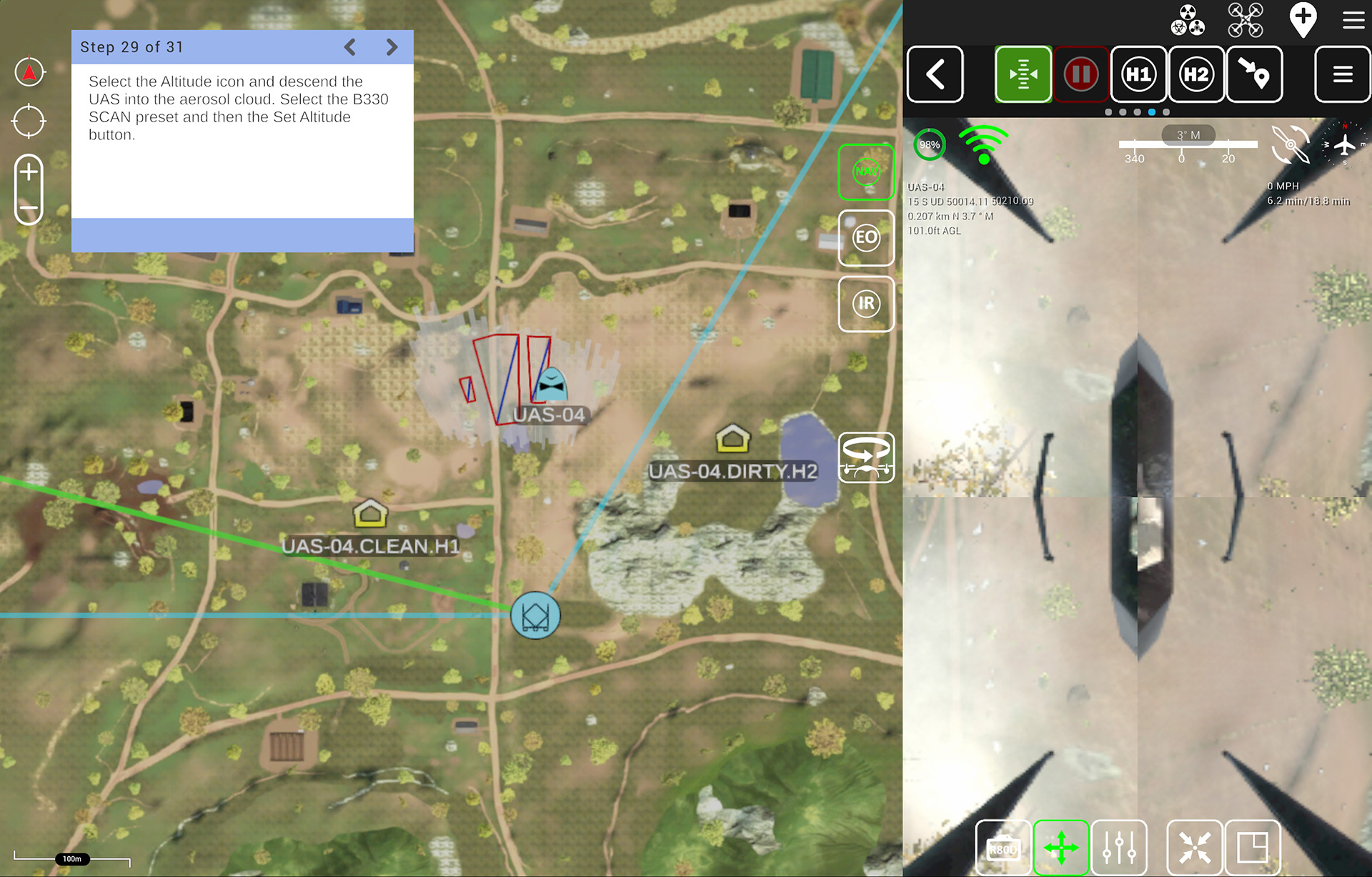
The navigation cameras look down while the UAS descends into the aerosol cloud prior to sampling.
Post-Collection Procedures
This lesson instructs the user to return the UAS to the dirty home base. It advises that the B330 collector be set to not pick up dust from landing. Once the drone has landed, the trainee simulates calling the unmounted team members to request they collect the drone. While the audio conversation plays, on-screen graphics provide text transcripts. The final step is to relinquish control of the drone.
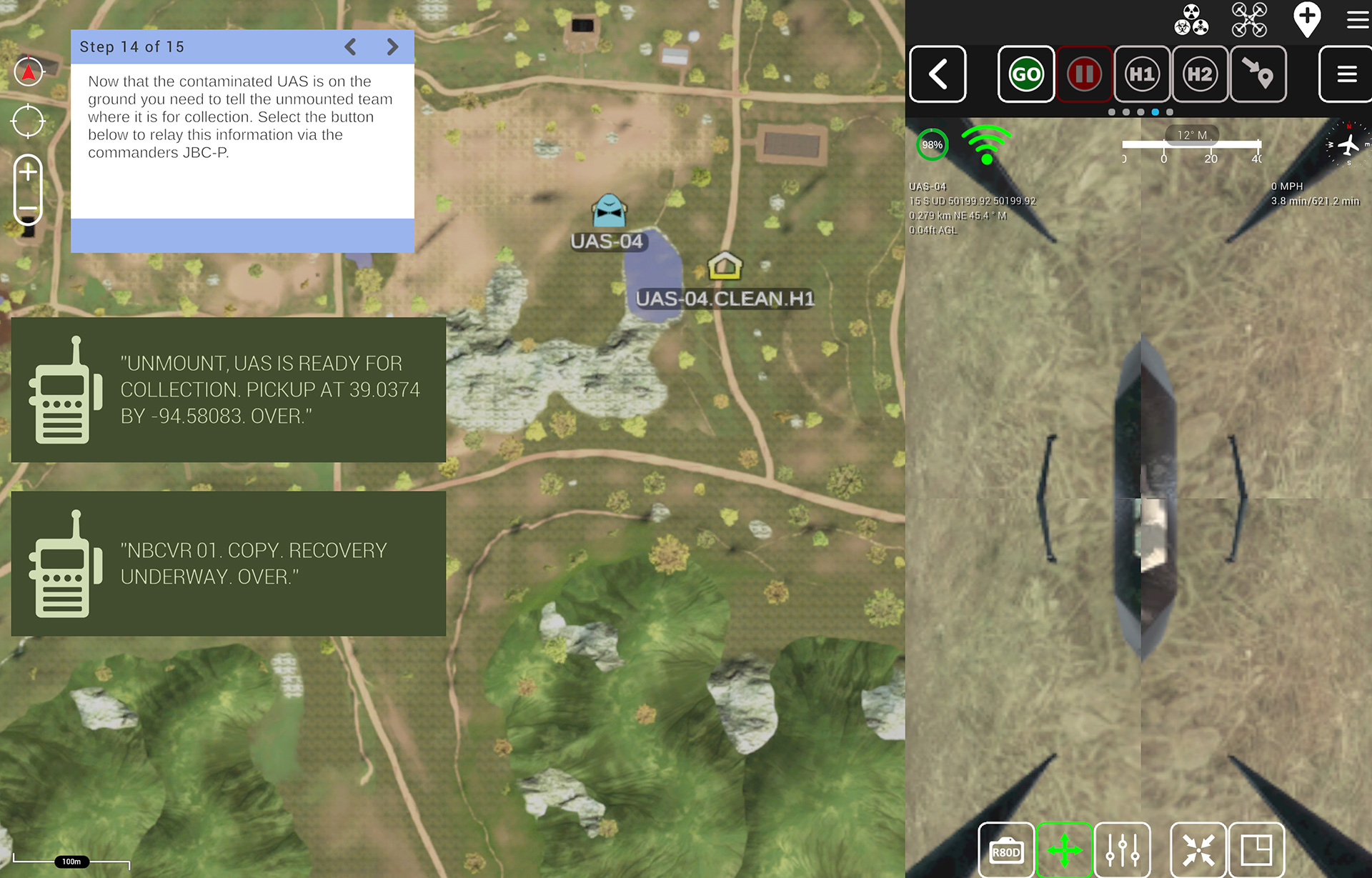
Radio communications for retrieval of the UAS.
Waypoint Flying Mission
In this evaluated scenario, the simulator generates the aerosol cloud in a random position. The trainee must perform the sequences practiced in the previous training lessons to complete a mission. The user can choose to run the scenario in day, dusk, or night mode. In night mode, the trainee uses the IR camera to view the drone’s surroundings.
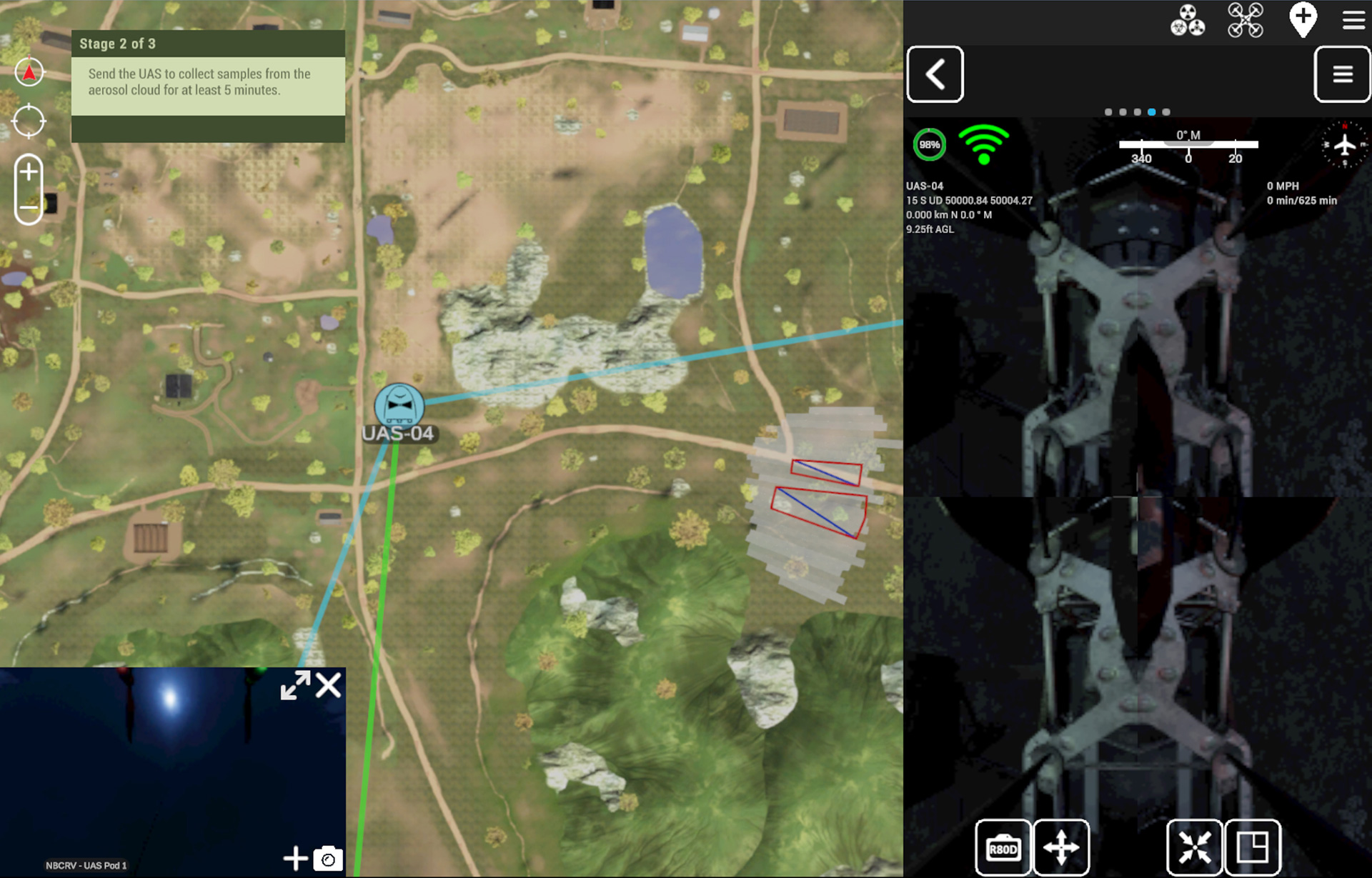
Pod and Skyraider camera views at night.

Dusk and infrared night views from the UAS in flight.
Driving Excellence Through Insightful Performance Analysis
At the mission’s conclusion, trainees receive a detailed performance report, grading them on total mission time, total flight time, sample collection time, number of collisions, and distance traveled. Medals—ranging from gold to participation—are awarded based on performance, along with a percentage score.
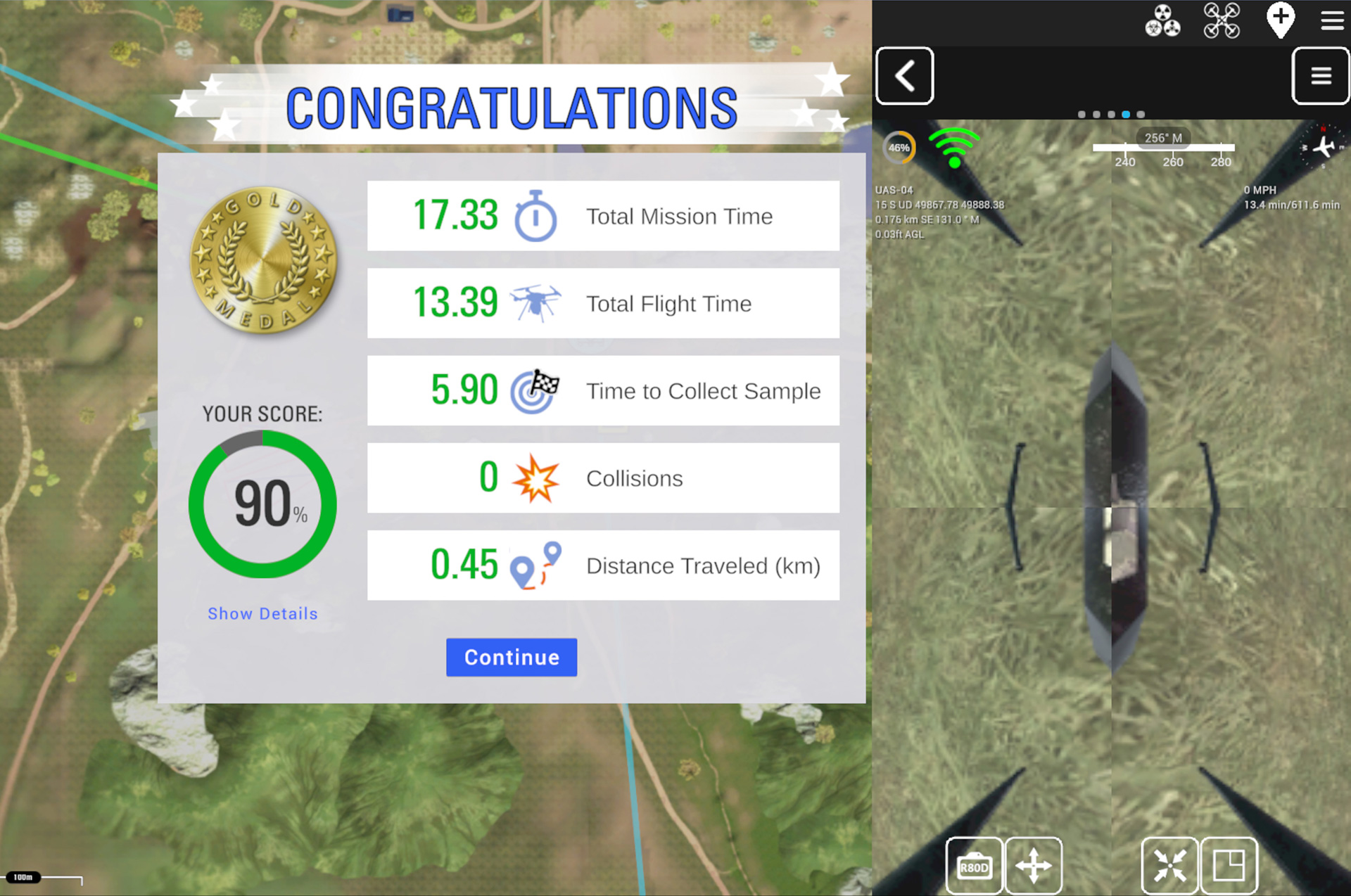
The Performance Report of a fairly successful mission. Clicking the Show Details link provides additional information, shown below.
A link to a detailed report itemizes any errors that the trainee had made, such as failure to reset the baseline of the B330 sensor or failure to employ the forward camera before sending the UAS to a waypoint.
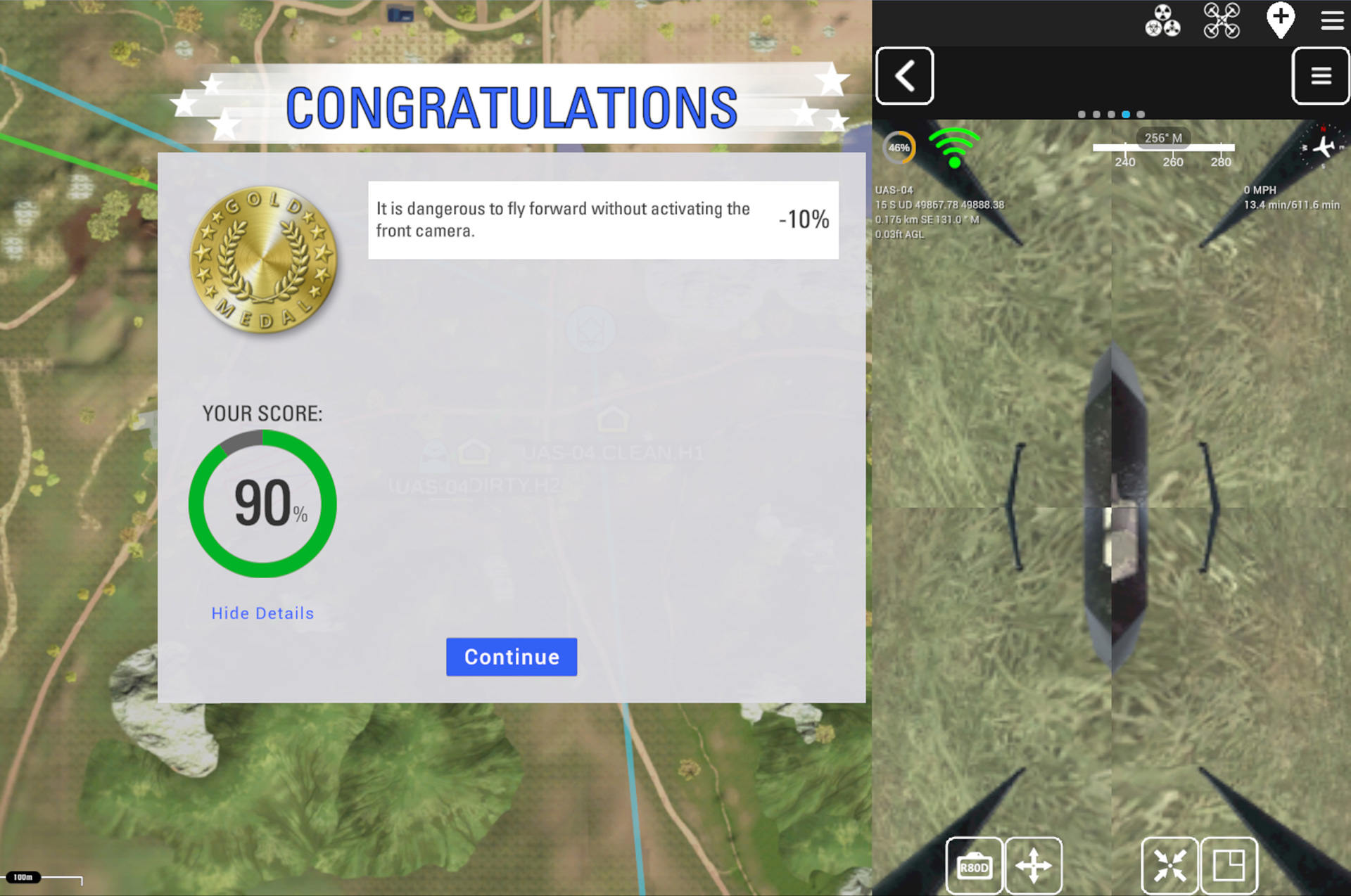
Detailed report itemizes errors that the trainee made, such as failure to employ the forward camera before sending the UAS to a waypoint.
With operator performance and expertise mission-critical factors in these types of CBRN surveillance missions, the real-time user performance analysis system likewise becomes a keystone component of the training simulator. By evaluating the trainee’s performance metrics, the system not only charts the user’s progress but also identifies specific areas for improvement, which results in actionable insights. Whether it’s adjusting flight patterns, understanding sensor readings, or maneuvering to avoid collisions, the feedback is tailored to guide and uplift each user’s proficiency. Performance analysis also helps to make the training more engaging. By providing real-time feedback and tracking the user’s progress, performance reports can create a sense of challenge and accomplishment. This can help to keep the user motivated and involved in the training. By intertwining state-of-the-art simulation with robust performance analysis, ForgeFX ensures that users of the Tele-Op Simulator are not just trained but are continually challenged and engaged, pushing the boundaries of their potential with every mission.
Benefits of the Tele-Op Simulator Training Program
In today’s dynamic and demanding training landscape, the Tele-Op Simulator is a benchmark for modern efficiency and innovation. First and foremost, its cost-effectiveness is undeniable. By transitioning to this simulated environment, organizations can sidestep the substantial expenses associated with real-world training exercises, all while achieving equal—if not superior—educational outcomes. In terms of accessibility, the simulator breaks down traditional barriers, offering trainees the flexibility to hone their skills irrespective of time, location, physical, and consumable constraints. This democratization of training ensures that all personnel, regardless of their geographical or logistical circumstances, have equal opportunity to excel. But perhaps the most compelling advantage is safety. The Tele-Op Simulator eliminates the risks associated with hands-on training, safeguarding both expensive equipment and invaluable human lives. In encapsulating these benefits, the Tele-Op Simulator presents an optimal fusion of cost savings, universal access, and uncompromised safety.
Take the Next Step in Training
The ForgeFX Unmanned Vehicle Tele-Operation Training Simulator is the perfect tool for anyone looking to train pilots or operators to control an unmanned aircraft or its payload from a control station. With realistic and accurate training in a virtual environment without the risks, constraints, and associated costs of a real flight, simulation training is unbeatable for creating more highly skilled UAS pilots, sensor operators, and mission commanders. If you’re interested in learning more about this product, that was developed for the Joint Program Executive Office – Chemical, Biological, Radiological, and Nuclear Defense (JPEO-CBRND), or would like to discuss how we can build something for you, please don’t hesitate to contact ForgeFX Simulations today.
About MRIGlobal
MRIGlobal is an independent, not-for-profit organization that performs contract research and development for government agencies, industry, and academia. With more than 75 years of experience, MRIGlobal has established a reputation for excellence in science and technology, and a commitment to finding innovative solutions to complex challenges. Their multidisciplinary team of experts works across a range of fields, including health, energy, national security, and the environment, to deliver high-impact results that improve lives and support economic growth. To learn more about MRIGlobal, visit their website at https://www.mriglobal.org/.
About Teledyne FLIR
Teledyne FLIR, a Teledyne Technologies company, is a world leader in intelligent sensing, unmanned systems, and integrated solutions for defense and industrial markets. Founded in 1978, the company develops a wide range of advanced technologies to help professionals make better, faster decisions that save lives and livelihoods. To learn more, visit https://www.flir.com/ or follow them on social media. #AnyThreatAnywhere.
About the JPEO-CBRND
The Joint Program Executive Office for Chemical, Biological, Radiological and Nuclear Defense (JPEO-CBRND) is a joint service organization within the U.S. Department of Defense tasked with protecting the armed forces from the effects of chemical, biological, radiological, and nuclear weapons. JPEO-CBRND’s mission is to provide innovative solutions to the warfighter’s CBRN defense needs, from detection and identification to protection and decontamination. Their team of dedicated professionals works in partnership with industry, academia, and government to develop and deliver cutting-edge technologies and capabilities that help safeguard the nation’s security. To learn more about JPEO-CBRND, visit their website at https://www.jpeocbrnd.osd.mil/.
About ForgeFX Simulations
ForgeFX is a training simulation software development company. Founded in 2002, ForgeFX develops high-quality custom interactive 3D simulation and visualization software products for clients across a wide array of industries. Leveraging high-fidelity 3D graphics and game engine development tools, ForgeFX provides virtual and augmented reality application development services for clients who are looking to distribute interactive simulation-based training solutions. Our training products—employed by industries including national defense, healthcare, pharmaceutical, insurance, mining, construction, and transportation—produce measurable improvements in trainee engagement and knowledge retention.
Want to learn more?
If you have any questions about this Unmanned Vehicle Tele-Operation Training Simulator, or for an assessment of requirements that are specific to your project, please contact ForgeFX Simulations. We welcome your inquires and are happy to discuss software development projects with potential customers.
Contact Us Learn More
